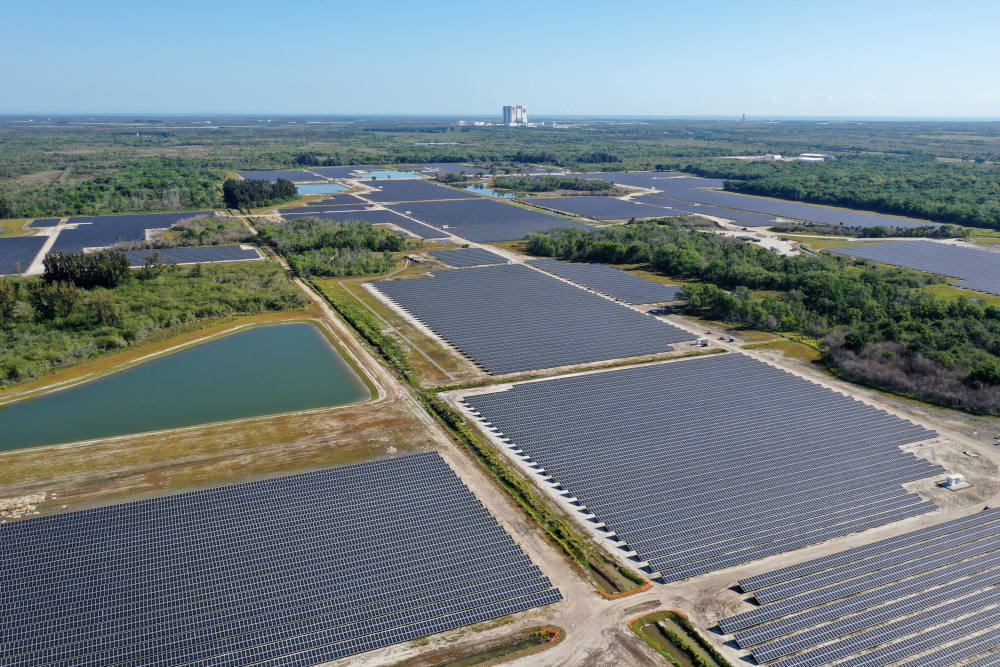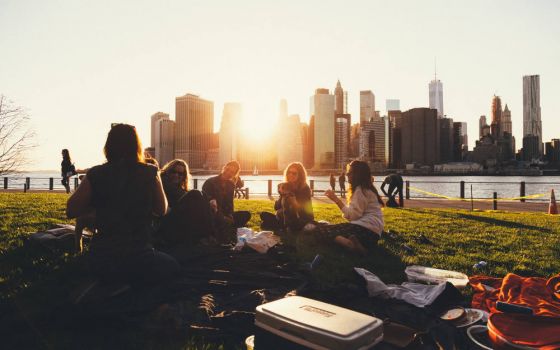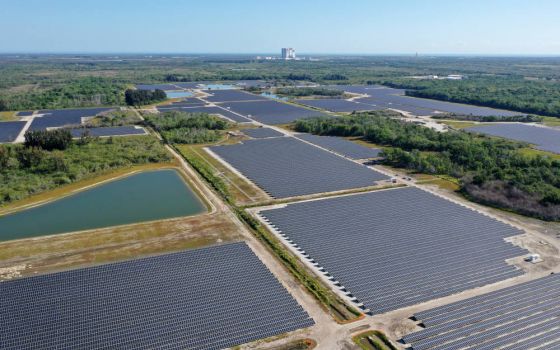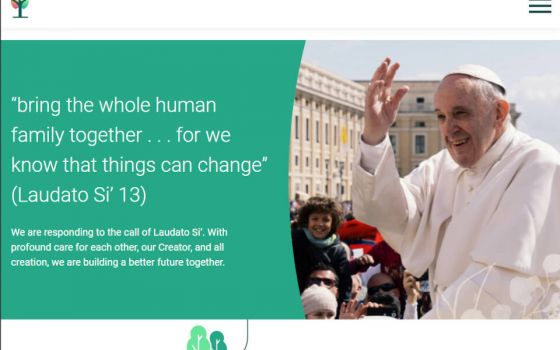
Florida Power and Light's new Discovery Solar Energy Center is a 74.5-megawatt solar site, spanning 491 acres at NASA's Kennedy Space Center in Florida. Its roughly 250,000 solar panels are expected to produce enough energy to power approximately 15,000 homes. (Flickr/NASA)
Editor's Note: EarthBeat Weekly is your weekly newsletter about faith and climate change. Below is the Jan. 7 edition. To receive EarthBeat Weekly in your inbox, sign up here.
If you're like me, when you hear the words "environmental justice" what first forms in your mind are pictures of polluting factories and power plants near a residential neighborhood. Maybe a congested highway overpass or malodorous city dump, too.
But the term, and its guiding principles, apply beyond how and where fossil fuels are extracted and burned and toxic dumping occurs, and where hazardous landfills are located. It also has to do with renewable energy, and how that major power shift is implemented as part of global efforts to limit climate change.
A timely example of that is playing out now in Florida.
Reporting this week for Inside Climate News, Aman Azhar chronicled the story of Archer, a historically Black town in northern Florida where residents successfully organized twice in the past two years to block construction of two large, utility-scale solar farms on nearby vacant farmland.
"It's a great idea. But it's in the wrong location," Gerrie Crawford, chair of the Saint Peter Saint Paul Community Council who lived near one of the proposed solar sites, told the online publication.
She and others in her community, a small town of roughly 1,200 people, had concerns about the proposed solar facilities' compatibility in their neighborhood, potential environmental harms for those living nearby and environmental racism and cultural factors — for instance, one of the plants threatened to disturb a cemetery and past energy projects left properties unusable or devalued.
Just as important, the residents were upset with the limited and late-stage engagement the solar companies had with their community, as they received notice on a fence post ahead of construction that was set to begin in months for a project they learned was years in development.
Frustrated with the lack of participation in decision-making, the neighborhood formed the Saint Paul Saint Peter Community Council, named after two Baptist churches that share the same road. Ultimately, the residents swayed Alachua County commissioners to vote against both solar projects.
Despite their victories, the Archer community still faces uncertainty with future proposals after the Florida Legislature and Gov. Ron DeSantis in the summer rushed through a new "preemption" law to stop local governments from blocking future energy projects.
The whole story is worth a read.
"We support renewable energy," Crawford told Inside Climate News. "But we feel it has to be a just transition to break the cycle of past injustices in the name of progress."
As you may recall, a just transition was the focus of a recent reporting series by Global Sisters Report.
Speaking from her experiences working with Indigenous communities in Peru who have opposed mining projects on their land, Maryknoll Sr. Patricia Ryan said that the local people "have to have a direct, vital part in any decision that is being made regarding their territory. They have to be a part of the decision-making process right from the beginning."
Other examples of environmental justice alarms ringing with renewable energy are seen in the ongoing campaign by the Apache Stronghold opposing a copper mine in Arizona that would destroy their sacred sites at Oak Flat, and in Nevada where tribes are battling mining projects for lithium and other rare minerals essential for creating batteries and other elements necessary for clean energy deployment.
In each of these cases, the focal point may have changed — from a coal-fired power plant or chemical factory to clean energy projects — but the environmental justice ramifications remain. All of this reminds me of something that Ruth Miller, a Dena'ina Athabaskan from near Bristol Bay, Alaska, told me while we spoke in the streets of Glasgow after an Indigenous rally at COP26:
"Our bottom line is don't create false solutions that harm us more," she said. "Don't create climate solutions that further colonization and oppression of Black, brown and Indigenous peoples. It is that simple."
Advertisement
What's new on EarthBeat this week:
- After spending portions of last year reporting on Catholic sisters' land conservation efforts in New York's Hudson Valley, Chris Herlinger of Global Sisters Report hopped on a boat with a Sister of Charity and a longtime environmental activist to learn more about the ecological importance of the Hudson River and the work being done to protect it.
- Jesuit Fr. Thomas Reese, columnist for Religion News Service, spent part of his holiday break binge-watching a new NOVA series on the universe, and it got him thinking: Why would God create such a huge universe with so many possible sources of life if he did not want thousands of species, including outside Earth, to bloom?
- Reactions to what transpired at COP26 continue, the latest from retired Brazilian Bishop Erwin Kräutler, a longtime leader of a territorial prelature in the Amazon, who compared the Glasgow summit a slow-acting "medical board that is discussing the future of our planet, which is in intensive care." Kräutler shared that and other thoughts in an interview with Fr. Luis Miguel Modino.
- A new report issued at COP26 describes in comprehensive scientific detail the natural and human history of the Amazon Basin, and just as important, it outlines potential solutions to the many threats facing the globally critical biome, writes former EarthBeat editor Barbara Fraser.
- And back at Global Sisters Report, Mercy Sr. Mary Bilderback reflects on the awe and astonishment she finds in God's creation, whether at the beach or in the convent garden.
What's happening in other climate news:
- A 17-story Sitka spruce that has stood for 500 years, capable of storing massive amounts of carbon, is marked for sale for $17,500, leading Juliet Eilperin of the Washington Post to explore the question: In an age of climate change, is such a tree worth more alive or dead? Check out the stunning visuals that accompany this top-tier reporting.
- While much focus has been on what President Joe Biden might accomplish on climate change, especially around the fate of the Build Back Better Act, Inside Climate News reviewed what his administration has done so far in year one on climate and environmental policies.
- Cecilia Martinez, the top environmental justice official in the White House, is leaving that position, reports Drew Costley of The Associated Press, who also has reactions from EJ leaders on the Biden administration's first year.
- In less than a month, the Winter Olympics are set to begin in Beijing, and for the first time the Chinese capital in 2021 reached its state air quality standards. But high pollution levels still pose a risk to residents. Yale Environment 360 has a round-up of the situation.
- In the East Texas city of Texarkana, the 2021 calendar year closed with … raining fish. Seriously. Tim Stelloh of NBC News has the story, and explanation, on an unusual weather phenomenon.
Upcoming events:
The National Black Catholic Congress is hosting a live webinar on Jan. 10 titled "Imagining our Ecological Future: Black life and Laudato Si'." It will be streamed 7-8:30 p.m., Eastern, on its social media platforms.
You can find more information about this and other events on the EarthBeat Events page, and you can add your own group's events here.
Final Beat:
At EarthBeat and NCR, we're always working hard to track down stories and keep our finger on the pulse of what's happening at the intersection of faith, climate and environmental justice. But we can only do so much ourselves. That's where you come in.
Is your parish, school, diocese, hospital or business planning to join the Laudato Si' Action Platform? We want to hear about it. (And even if they've decided not to.) Is there an environmental justice issue at play in your town or community? Is your parish or local faith community involved? We want to hear about it.
Drop us a line at earthbeat@ncronline.org with your story tips, or other ideas you might have to help inform our coverage in 2022.
As always, please forward this email, or pass along the link to EarthBeat Weekly on our website, to a friend who might appreciate EarthBeat.
And of course, thanks to you for reading.







